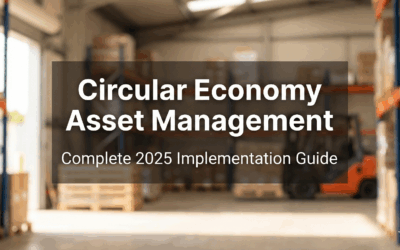IT Asset Disposition (ITAD) – Complete Guide 2025: Process, Costs & Compliance
What is ITAD?
IT Asset Disposition (ITAD) is the structured, secure and environmentally responsible process by which organisations retire, sanitise, remarket, recycle or destroy outdated IT hardware, ensuring data protection, regulatory compliance and value-recovery.
Why ITAD Matters
When an organisation retires IT hardware, the process is not simply “throw away the server” or “send the laptops to recycling”. The end-of-life stage of IT assets touches on three converging pressures: data security, regulatory & environmental compliance, and value recovery.
Data security & breach costs
• Retired devices often contain data — from user credentials to customer financial records to intellectual property — and this remains a risk if assets are not properly handled.
• The average cost of a data breach recently is about US $4.45 million, making the data risk of e-waste disposal a business-critical issue.
Regulatory & environmental drivers
• Under Basel Convention amendments (effective 1 January 2025) all electrical and electronic waste (e-waste), hazard or non-hazardous, will become regulated for trans-boundary movement, increasing compliance burdens for global ITAD.
• In the U.S., more than 25 states now have e-waste laws. Non-compliance can bring heavy fines, reputational damage and audit risk.
• Data protection laws such as the GDPR (up to €20 million fines) and HIPAA (for health sector) further amplify risk for disposed hardware containing data.
Value recovery & sustainability
• The global investment-recovery / ITAD market is estimated at US $25.31 billion and projected to grow to ~US $54.54 billion by 2030 at ~14% CAGR.
• Rather than purely a cost centre, an effective ITAD programme can become a value-recovery engine — remarketing usable assets, extracting parts, reducing procurement spend.
• From an ESG/sustainability standpoint, responsibly disposing of or reusing IT equipment supports circular-economy goals and reduces e-waste risk.
In short: if you are an IT Director, CIO, Procurement Leader, Compliance or Sustainability Officer in a Fortune 1000 organisation, you cannot treat ITAD as an afterthought. A fully articulated ITAD program is business-critical.
How Does ITAD Work? (The 6-Step Process)
For clarity, here is a numbered list of the six major steps in a best-practice ITAD program:
- Asset Inventory & Identification
- Catalogue all end-of-life hardware: desktops, laptops, servers, storage arrays, networking equipment, mobile devices, peripherals.
- Tag and serialise assets; map location, user, data-classification, expected disposal method.
- Establish chain-of-custody from the moment of decommissioning.
- Data Sanitisation & Secure Data Destruction
- Apply recognised standards (e.g., NIST SP 800‑88 “Clear, Purge, Destroy” framework) to ensure data cannot be recovered.
- Choose method based on media type (HDD, SSD, tape), data sensitivity, reuse vs. disposal decision.
- Document certificate of destruction, sanitisation logs, verification sampling.
- Remarketing / Reuse or Recycling / Disposal
- Assess whether hardware is reusable: refurbishment, remarket, donate.
- If not reusable, recycle in environmentally-sound manner: separation of plastics, metals, circuit boards, hazardous components.
- Maintain downstream vendor due-diligence: ensure recyclers are certified, follow export restrictions, maintain chain-of-custody.
- Reporting & Chain of Custody Documentation
- Generate detailed reports: serial numbers, sanitisation method used, remarketing value realised, recycling disposition, certificates.
- Maintain auditable logs for compliance — both data protection and environmental (e.g., e-waste laws).
- Certificate of Destruction / Final Disposition
- Provide a “Certificate of Destruction” (CoD) for assets physically destroyed or securely disposed.
- For reuse/remarket assets, provide “Certificate of Reuse/Receipt” confirming secure handling.
- Ensure documentation is suitable for audit by e.g., regulatory, insurance, internal audit teams.
- Compliance & Process Review
- Confirm all steps align with regulatory requirements (data, environmental, health & safety).
- Audit vendors, review internal processes annually (or sooner), adjust as laws and technology evolve.
- Leverage value-recovery metrics and continuous improvement to optimise programme.
Why this process matters
Following a robust process ensures your organisation:
-
Mitigates data risk and potential breach costs.
-
Demonstrates due-diligence in audit scenarios (data-governance, environmental regulatory).
-
Maximises residual value of assets.
-
Ensures sustainability and compliance with evolving global e-waste rules.
What Does ITAD Cost? (and Value Recovery)
Breaking down the cost structure and ROI for ITAD is critical for stakeholders (CFO, Procurement Manager).
Cost structure breakdown
-
Per-device pricing: Many ITAD providers charge a flat fee per device (laptop, server, storage array), which covers collection, transport, data sanitisation, recycling/disposal.
-
Hidden costs to watch for:
-
On-site decommissioning / lift & shift fees
-
Transport and logistics (especially large data-centre assets)
-
Export/disposal fees for hazardous e-waste or global shipments
-
Vendor downstream-audit fees (for export/import compliance)
-
Failure to capture remarketing value because of poor condition or market timing
-
-
Value recovery offsets: Assets that can be refurbished and remarketed generate credit or revenue – reducing net cost of disposal. As noted, ITAD is increasingly a value-recovery opportunity, not just a cost.
ROI calculation: $20 : $1 profit leverage
An example: Suppose you spend $100,000 annually on device disposal. With a mature ITAD programme you might capture $2 million in remarketing value, yielding a value-leverage ratio of 20 : 1 ($2 m return / $100k cost). This kind of leverage is achievable when you optimise inventory, remarket aggressively, and partner with certified vendors.
Key cost-benefit levers for decision-makers
-
Reduce per-unit disposal cost via volume, standardisation of assets, contract terms.
-
Increase value recovery via timely remarket, standardised secure-erase, asset-tracking.
-
Minimise risk cost (breaches, fines, brand damage) by high-integrity data-destruction approach.
-
Improve sustainability metrics (which can translate into lower energy/IT procurement spend, improved ESG ratings).
When presenting to a CFO or procurement committee, highlight that ITAD is not just “trash management” — it is a strategic investment that can contribute positively to the balance sheet and risk profile.
Compliance Requirements Deep-Dive
Modern enterprises must navigate a complex compliance landscape: data protection, media sanitisation standards, environmental laws, global e-waste treaties, and vendor certification programmes.
Data destruction standard: NIST SP 800-88
-
Developed by National Institute of Standards and Technology (NIST), the publication “Guidelines for Media Sanitization” (SP 800-88) remains a key standard.
-
It defines three levels of sanitisation: Clear, Purge, Destroy.
-
Verification and documentation of the sanitisation step are required to “render access to target data on the media infeasible for a given level of effort”.
Certification frameworks: R2v3, e-Stewards & NAID AAA
Here’s a comparison table to clarify these certifications:
|
Certification |
Focus / Scope |
Key Features |
|---|---|---|
|
R2v3 |
Electronics reuse & recycling standard |
Overseen by SERI; covers environment, worker safety, data security. |
|
e-Stewards |
Rigorous standard for e-waste recyclers |
Bans export to developing countries; integrates NAID AAA for data destruction. |
|
NAID AAA |
Certified data destruction / media sanitisation |
Focus on chain-of-custody, audits, data security standards. |
Environmental / Transboundary compliance: Basel Convention Amendments
-
As of 1 January 2025, the Basel Convention’s e-waste amendments take effect, making all electrical & electronic waste (hazardous and non-hazardous) subject to the Prior Informed Consent (PIC) procedure for cross-border shipments.
-
This impacts organisations that export retired IT assets, components, scrap or recycling processes.
-
For example: “Y49” code now covers non-hazardous e-waste, and “A1181” covers hazardous e-waste under updated Annexes II/IX.
State & national e-waste and data-protection laws
-
U.S. states: Over 25 with dedicated e-waste legislation – requiring certified recyclers, reporting, proper disposal of specific devices.
-
Data-protection laws (GDPR, HIPAA, CCPA) may impose obligations for how data-bearing devices are disposed even before sending them off-site.
-
Internal policy: Organisations should treat ITAD as part of their IT Asset Lifecycle Management (ALM) policy, ensuring alignment with Procure-to-Retire workflows.
Chain of Custody & Documentation
-
It is critical to maintain chain-of-custody throughout the ITAD process: from de-installation, transport, sanitisation, processing, recycling/disposal.
-
Certified vendors will provide documentation including: asset tag lists, sanitisation certificates, disposal certificates, downstream vendor disclosures, audit records.
-
Without proper documentation, your organisation may face audit, regulatory or insurance exposures.
Why Use Certified ITAD Services?
Selecting a vendor for IT Asset Disposition is more than booking a recycling truck; it requires due-diligence. Below is a vendor-selection checklist, followed by red flags and an RFP template outline.
Certification checklist
-
Vendor certified under R2v3 or e-Stewards for recycling.
-
Vendor certified under NAID AAA (or equivalent) for secure data destruction.
-
Vendor maintains documented chain-of-custody and provides serialised asset tracking.
-
Vendor adheres to NIST SP 800-88 sanitisation methods (Clear/Purge/Destroy) and provides certificate of destruction.
-
Downstream vendor due-diligence in place (exports, recycling sub-contractors).
-
Vendor assists with global compliance (Basel Convention export/import, if applicable).
-
On-site reporting and audit access (e.g., client portal for disposition reports).
-
ESG / sustainability credentials: e-waste diverted from landfill, circular economy metrics.
Vendor audit questions
-
Do you segregate assets by reuse, refurbishment, recycling and disposal?
-
What is your transport and chain-of-custody protocol?
-
How do you document sanitisation? Provide a sample certificate of destruction.
-
Are your downstream vendors certified (and how do you track them)?
-
How do you handle trans-boundary movement/export of e-waste? Are you Basel-compliant?
-
How do you handle devices that may contain batteries, CRTs, or other hazardous components?
-
What remarketing channels do you have for refurbished assets? What residual value can you pass back to us?
-
What is your pricing structure (per asset, site decommissioning, lift/shift, logistics)?
-
Provide sample audit reports & client references with global (multi-site) coverage.
-
What happens in case of audit / incident / data breach from retired assets?
Red flags
-
Vendor claims “all devices go to landfill” or “no remarketing channel”.
-
No certification in place or unwilling to provide proof.
-
Lack of asset-tracking or serialisation of retired hardware.
-
No certificate of destruction or ambiguous sanitisation methodology.
-
Subcontractor network is opaque or unverified.
-
Export of retired assets without clear compliance with Basel Convention or local e-waste laws.
-
Pricing significantly below market with no value-recovery model (may imply dumping).
Summary & Key Takeaways
-
ITAD is no longer a “nice to have” — it’s a core component of IT lifecycle, compliance and value-recovery.
-
Make sure your ITAD programme follows the six-step process and is fully documented.
-
Cost is important, but emphasise value recovery and ROI — not just disposal fees.
-
Compliance is multi-dimensional: data destruction (NIST SP 800-88), recycling/export laws (Basel 2025), state e-waste, vendor certification (R2v3, e-Stewards, NAID AAA).
-
Vendor selection is critical: use a robust checklist, press for certifications, asset-tracking, and turn your ITAD vendor into a strategic partner.
With data risks high, regulatory stakes escalating (especially with the 2025 Basel amendments), and global IT refresh cycles accelerating, a disciplined ITAD approach can protect your business, recover hidden value, and position your organisation as a sustainability leader.
Closing note: The ITAD landscape is evolving rapidly in 2025 — both from regulatory pressure and from the growing value-recovery opportunity. By implementing a well-architected ITAD programme, choosing certified partners, and documenting your process end-to-end, your organisation can turn end-of-life IT assets from a liability into an asset.


